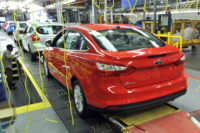Simulated driving has its serious side and its fun side. On the serious side, the technology is regularly used in driver’s education courses, as well as to monitor driver behavior, performance and attention, and evaluate advanced driver assistance systems.
As for its fun aspect, simulators allow everyone to briefly drive the vehicles of their dreams. A good example is the simulator developed by Sigma Integrale (SI) for Fiat-Chrysler Automotive (FCA)—now known as Stellantis—so auto show attendees could get safely behind the wheel of the company’s Dodge SRT Demon muscle car.
“After working closely with FCA for three years on various projects, Dodge came to us in 2016 and said they were working on a secret project car [the SRT Demon] based on their Challenger line,” says Howard Lin, principal and head of engineering at SI, a company that develops full-motion vehicle systems to simulate real driving. “FCA wanted us to create a drag-racing experience with a pair of car simulators for use at auto shows.”
The simulators are placed side-by-side to allow head-to-head drag racing, so to speak, and each features an actual SRT Demon without a drivetrain. In front of each car is a large video screen of a quarter-mile track. Between the cars is an array of starting lights known as a “Christmas tree.” Test drivers compete to achieve the lowest elapsed time and highest top speed.
Recreating the feel of acceleration in the SRT Demon was a big, but welcome, challenge for SI engineers. The Demon goes from 0 to 60 mph in a mere 2.3 seconds and generates about 1.8 g off the starting line. To recreate this movement, Sigma needed four fast and powerful actuators in the suspension; two in front and two in back.
The only way we could simulate initial acceleration was with brute force,” explains Lin. “That meant replacing the suspension parts with electric actuators capable of producing 2,000 pounds of force each, and lifting the front end 12 inches within a fraction of a second. The actuators also had to be compact enough to fit into the suspension space without altering the outside appearance of the car.”
Equally important, the actuators had to be programmable and demonstrate reliability with low or no maintenance. After extensive research, Lin selected RSA electric linear rod-style actuators from Tolomatic Inc. He acknowledges that the supplier’s helpful design tools, such as actuator sizing software and free downloadable CAD drawings, played a part in his final decision.
RSA-ST actuators feature high-thrust bearings, internal bumpers and planetary roller-screws (ball, solid or bronze) that deliver accurate force up to 40,257 newtons. A rigid, strong aluminum housing allows for easy mounting of switches and sensors.
The actuators have a stroke length of 12 to 60 inches and are suitable for pneumatic replacement and general motion control applications. Heavy duty RSA-HT actuators are suitable for valve actuation, punch press and injection-molding applications. They produce a force up to 58,001 newtons.
The FCA dual simulators debuted at the New York Auto Show in early 2017. Since then, they have appeared in various auto shows and National Hot Rod Association (NHRA) events, including the NHRA Gatornationals this past March in Gainesville, FL.
For more information on rod-style actuators, call 833-647-0681 or visit www.tolomatic.com.







